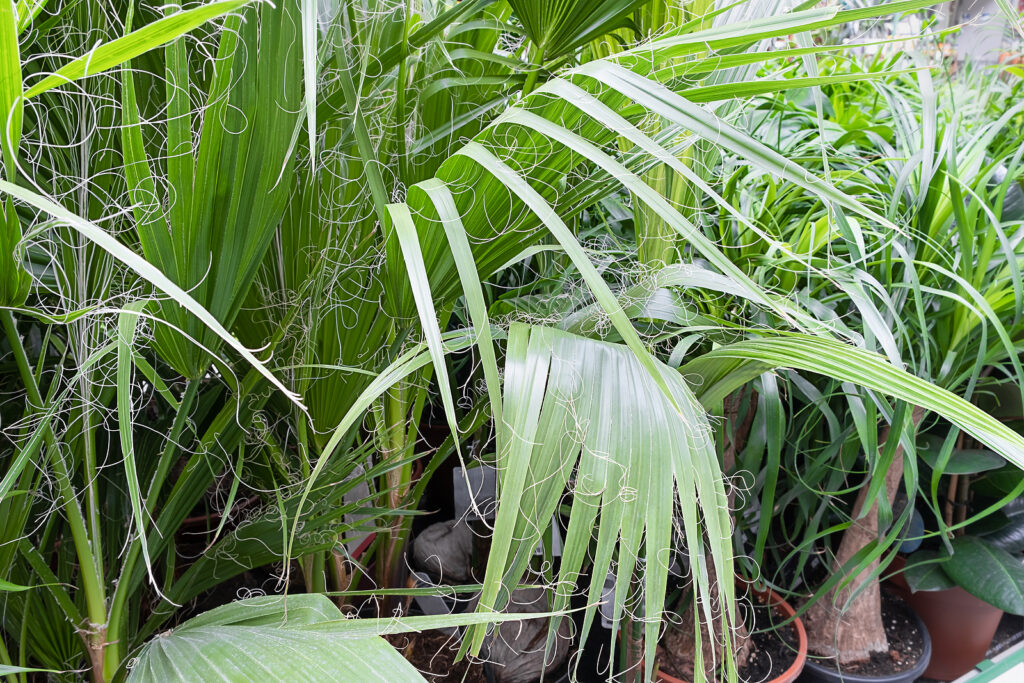Washingtonia–commonly called fan palm–are palm trees with deeply lobed, fan-shaped leaves borne in terminal heads that form a dense, shaggy thatch around the trunk of the tree as the leafy fronds die back.
Washingtonia grows 50 to 80 feet (15-25m) tall and 10 to 15 feet (3-5m) wide. They are best suited as street trees or specimens in very large lawns. They grow too tall for most suburban gardens. That said, Washingtonia can be grown in pots indoors where it will rarely grow taller than about 8 feet high in a container.
Washingtonia is a subtropical plant native to Southern California and northern Mexico. It grows best where there is little or no frost. It can tolerate dry heat, but grow best in a slightly moist or humid environment.
Washingtonia is a genus of two species.
Get to know Washingtonia
- Plant type: Palm
- Growing zones and range: Zones 8 to 11
- Hardiness: Hardy to 30°F outdoors
- Optmal growing temperature indoors: Average room temperature
- Height and width: 50 to 80 feet (15-25m) tall and 10 to 20 feet (3-6m) wide.
- Foliage: Deeply lobed, fan-shaped leaves are borne in terminal heads that form a dense shaggy thatch on the trunk as they die back. Fronds are cut into many narrow, stiff leaf segments. Shredded brown fibers dangle from the leaf sections.
- Flowers: Tubular, creamy white or creamy pin flowrs with 3. petal lobes
- Bloom time:
- Uses: Plant on large properties, along avenues and parkways; grow too trall for suburban gardens
- Common name: Fan palm
- Botanical name: Washingtonia
- Family name: Arecaceae
- Origin: California, Arizona, northern Mexico

Where to plant Washingtonia
- Plant Washingtonia in full sun.
- Give Washingtonia full, bright light when grown indoors. Indoors Washingtonia need average room temperature and low to medium humidity.
- Grow Washingtonia outdoors in humus-rich, well-drained soil.
- Grow indoors in a soil-based potting mix.
When to plant Washingtonia
- Set container-grown Washingtonia in the garden in spring or autumn.
Planting and spacing Washingtonia
- Space Washintonia 10 to 20 feet (3-6m) apart.
How to water and feed Washingtonia
- Water Washingtonia moderately. Overwatering can kill these plants. Keep Washingtonia almost dry during the winter.
- Grows fastest when watered regularly. Water less frequently in humid semi-tropical regions.
- Apply a balanced liquid fertilizer monthly.
Washingtonia care
- Remove dead fronds periodically. Dead fronds can be a fire risk.
- Washingtonia grown indoors should be repotted only when the tree outgrows its container, and an all-purpose soil mix can be used.
Growing Washingtonia as a houseplant
- Washingtonia needs bright light, average room temperature, and low to medium humidity.
- Washingtonia can tolerate dry air, but it grows best in a slightly moist environment.
- Washingtonia can be placed outdoors in summer to promote good foliage color and growth provided it is in a location that is protected from the scorching sun and fierce winds.
- The soil should be kept moderately moist.
- Fertilizer should be applied in spring and summer.
Washingtonia pests and diseases
- Washingtonia is prone to scale insect, spider mites.
- Viruses, pink rot, bud rot, butt rott can occur.
Washingtonia propagation
- Sow sed at 75°F (24°C) in spring.
Washingtonia varieties to grow
- Washingtonia filifera, California fan palm, thread palm Grows to 70 feet (20m) tall; long-stalked leaves are 3 to 6 feet long and stand out from the crown of the plant; leaves droop as they mature creating a skirt of leaves.
- W. robusta, Mexican fan palm. Grows to 100 feet (30m) tall; slim and slightly curved trunk; shorter leafstalks than W. filifera; leaves have a red streak underneath.















